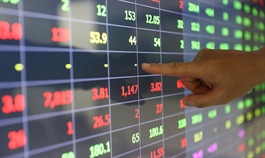Energy stocks benefit from higher oil prices
Energy stocks benefit from higher oil prices
Surging oil prices, recovering demand and tighter supplies have boosted energy stocks, supporting the general stock market.

In the international market, oil prices skyrocketed on Monday, with Brent breaching over US$80 per barrel for the first time in three years, as investors were concerned about tighter supplies against rising demand in many parts of the world post-pandemic.
In fact, Brent crude has jumped since the beginning of the year, up more than 39 per cent, as economies recover from the COVID-19 pandemic.
The growth in oil prices helped energy stocks to rise sharply on Tuesday, boosting the market sentiment.
PetroVietnam Gas (PVGas) was the biggest gainer in Tuesday's trade and led the market's uptrend. It climbed 5.67 per cent.
Petrolimex (PLX), PetroVietnam Drilling & Well Services Corporation (PVD), Vinacomin - DeoNai Coal JSC (TDN), Vinacomin - Vang Danh Coal JSC (TVD) and Vinacomin - Mong Duong Coal JSC (MDC) also posted strong performance.
These stocks continued rallies on Wednesday while the market faced headwinds as rising selling pressure weighed on bank stocks.
Besides PVD shares, the rest still gained more than 1 per cent. Of which, GAS shares rose 1.8 per cent, PLX shares were up 1.76 per cent, TDN increased 2.79 per cent, TVD inched up 3.87 per cent and MDC rose 1.78 per cent.
The outlook for the oil industry is optimistic, with Goldman Sachs recently raising its year-end forecast for Brent crude to $90 per barrel.
On Tuesday, the Organization of the Petroleum Exporting Countries (OPEC) also forecast that oil demand will grow sharply in the next few years. Meanwhile, several members of the group of producers have been having trouble raising production to meet recovering demand.
OPEC expected demand will rise by 1.7 million barrels per day (bpd) in 2023 to 101.6 million bpd. The group also said that global producers need to keep investing in production to avert a crunch despite an energy transition.
The supplies are tighter as production in the US continues to be disrupted after two Hurricanes Ida and Nicholas.
The gas industry also has a lot of potential, Vietinbank Securities said in the gas industry report.
Currently, most of the gas output is being used for electricity production, then nitrogen fertilisers.
Of which, in the average annual gas demand structure, the electricity industry accounts for 77 per cent, the fertiliser industry 19 per cent and 4 per cent for other industries.
With the decrease in nitrogen demand and the policy of developing electrification in the future, Vietinbank Securities forecast that the proportion of the electricity industry in the structure will increase to 84 per cent, the fertiliser industry falls to 9 per cent, the rest will be for the other industries.
But since the end of 2019, Viet Nam has started to record a shortage of gas supply to meet these two main industries, while production during 2021-2022 is expected to be unchanged at around 10-12 billion cubic metres, Vietinbank Securities said.
Given stronger Vietnamese electricity demand on economic and demographic growth factors, the gas supply will only be enough to meet demand until the White Lion field project is officially in operation in 2023, the securities firm added.
After the White Lion field goes online, the gas output can rise up to 12.5 billion cubic metres.
The energy demand will also be boosted by the shift of supply chains as many manufacturers have moved their production plants to Viet Nam.
The market ended lower Wednesday due to losses in bank stocks. The benchmark VN-Index on the Ho Chi Minh Stock Exchange (HoSE) dropped 0.01 per cent to 1,339.21 points.




























